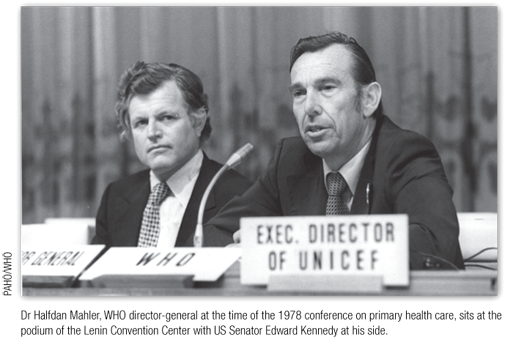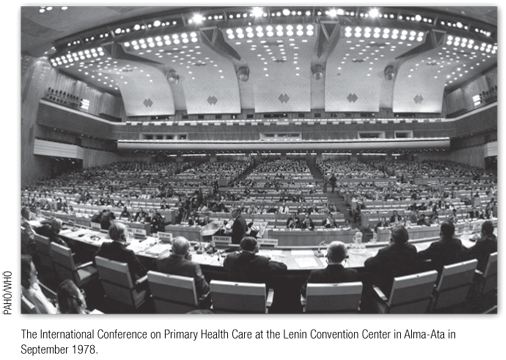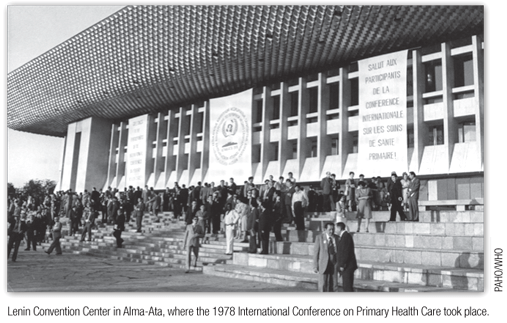NEWS
Consensus during the Cold War: back to Alma-Ata
This month Kazakhstan is hosting a conference to mark the historic International Conference on Primary Health Care held 30 years ago in Alma-Ata, now called Almaty. Fiona Fleck reports on the origins of the 1978 conference and of primary health care the strategy and approach devised 30 years ago to achieve the goal of 'health for all' the people.
On a cold January day in 1976, Dr Dimitri Venediktov, the Soviet deputy health minister, turned up unannounced at his colleague's home in Geneva.
It was the eve of the World Health Organization's (WHO's) Executive Board. Member States had decided the previous May, at the 28th World Health Assembly, that an international conference on primary health care, proposed by the Soviet Union, was "desirable". But funds were needed and a venue had yet to be named, and Moscow was lobbying hard to host it in the Soviet Union.
"I'll give you US$ 2 million for an international conference on primary health care," Venediktov told assistant director-general Dr David A Tejada de Rivero, according to the Peruvian physician, who recalls how the Soviet offer took him by surprise.
The following day, Venediktov repeated his offer to the Executive Board which accepted it on one condition: the conference would not be held in Moscow as Venediktov proposed but in a developing country.
In the midst of the Cold War, in a world divided between communist and capitalist spheres of influence, primary health care a new concept at the time became the unlikely vehicle for a political and ideological battle, especially in the socialist camp.
The concept of primary health care did not appear overnight. Some trace it back to an intergovernmental conference in Bandoeng, Indonesia, in 1937. That conference was held by the health organization of the League of Nations a predecessor to WHO that recommended that "the greatest benefit to the health of the rural populations, at the smallest cost, can be obtained through some process of decentralization".
This recommendation was in line with the vision of missionaries working in community health care in developing countries. Notably, the Christian Medical Commission (CMC), which was part of the World Council of Churches, encouraged the training of village workers at grassroots level, equipped with essential drugs and simple methods. In an article published in the American Journal of Public Health in November 2004, historian Marcos Cueto writes that the CMC created a journal called Contact that may have used the term 'primary health care' for the first time.
In 1974, WHO director-general Dr Halfdan Mahler, one of the driving forces behind primary health care, invited the CMC to present its community health work in developing countries to WHO directors, writes historian Socrates Litsios in his essay on the 1978 Alma-Ata conference published in the International Journal of Health Services in 2002.

In the 1960s and 1970s, it was the failure of single-disease programmes, such as those for malaria and yaws, and the lack of coordination between them that prompted countries to ask WHO for help in building their health services. Many of these countries had recently made the transition from colonialism to independence, and were facing the challenge of how to extend health services, which had been designed for colonial elites, to the masses.
But while Mahler and Tejada de Rivero were fully aware of countries' pressing needs for better health services, both felt it was too soon for a conference on primary health care. "At first I thought maybe it would be better to wait to have more experience in applying primary health care principles," Tejada de Rivero tells the Bulletin. But the decision to go ahead with a conference was final.
The Soviet Union saw the conference as an opportunity to showcase its socialist achievements in providing health for all and to promote the benefits of its centralized state-run health service in the hope that this system would, in turn, be adopted and rolled out across the developing countries.
In his 2005 interview in WHO's oral history series, Tejada de Rivero recalls how Venediktov explained that his country had lobbied hard to host the conference because, as the leading Socialist power, the Soviet Union could not "permit a Chinese victory" in the developing world.
As Tejada de Rivero wryly remarks in a 2003 article published in Perspectives in Health, the magazine of the Pan American Health Organization: "Alma-Ata, which means 'father of the apples' was in the republic where the Soviet Union had its Cold War space programmes."
"It was also next to China," Tejada de Rivero notes, underscoring the political rivalries that prevailed at the time. China was a world leader in the new approach to providing health for the people. China's barefoot doctors, young recruits sent to rural areas to educate people about health and provide basic treatment, were a major inspiration to the primary health care movement. But unsurprisingly, China was absent from the Soviet-sponsored conference the first-ever international conference on primary health care.
Mahler put Tejada de Rivero in charge of finding a venue and organizing the event a task that would take him 29 months and several trips to the Soviet Union and other countries. At first, WHO had considered Costa Rica, Egypt then Iran as possible sites for the conference, but failed to gain funds for any of these.
"So I had to return to the Soviet Union," Tejada de Rivero says, recalling how he travelled with his Russian colleague, Venediktov, to the republics of Azerbaijan, Kazakhstan and Tajikistan. "Dr Venediktov made an excellent contribution and had an acute political instinct that I very much admired," Tejada de Rivero tells the Bulletin.
Together, they selected the Kazakh capital, Alma-Ata because it had "a very impressive conference hall" and the minister of health Professor Turgeldy S Sharmanov was "a very dynamic person". To handle the red tape involved in customs and visa procedures for participants from Member States, international agencies and nongovernmental organizations (NGOs), a large contingent of WHO staff some 275 members were flown out to Alma-Ata a few days in advance.
Within the space of a year, the Soviet authorities had built a 1000-bed hotel in Alma-Ata. The Lenin Convention Center there with its auditorium for 3000 people had a simultaneous interpretation system and earphones at every seat, but communication was only from the podium to the audience. "This was the Soviet system," says Tejada de Rivero, who contracted an Italian company to install a system that allowed participants to join in the discussions.


Word about the conference spread fast. Senator Edward Kennedy turned up at the last minute, not as an official member of the US delegation but, as Tejada de Rivero recalls, his presence was "well-received" as it showed the political importance of the conference.
The conference was co-hosted with the United Nations Children's Fund. Documents were drawn up a year in advance. A key person in their development was WHO's Dr Kenneth Newell, who had edited a seminal work in the growing body of primary health care literature Health by the people published by WHO in 1975.
The Declaration of Alma-Ata on 'health for all' and its accompanying recommendations had been through many consultations at Regional Committees and other meetings before they reached the conference.
Tejada de Rivero and Mahler recall a lot of fighting over the text of the Declaration during the months of preparation, but as Mahler puts it "there was an overwhelming feeling that 'we must arrive at a consensus'".
In the end, 134 Member States, 67 international organizations and dozens of NGOs attended the three-day event. Both Tejada de Rivero and Mahler recall a spirit of cooperation. "It was almost a spiritual atmosphere, not in the religious sense, but in the sense that people wanted to accomplish something great," Mahler tells the Bulletin in this month's interview (747748).
The ground-breaking consensus that participants reached at the conference was that primary health care would be the key strategy that countries would use to achieve health for all of their people. And it was on this vital decision that all 134 participating countries agreed on 12 September 1978, in the midst of the Cold War.
"At the end of the conference, a young African woman physician in beautiful African garb read out the Declaration of Alma-Ata," Mahler says. "Lots of people had tears in their eyes. We never thought we would come that far. That was a sacred moment." 
